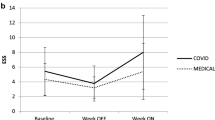Abstract
The potential deleterious effects of doctors’ long and arduous shifts have received relatively scant attention.
This study addressed the effect of a 32 h on-call shift on 16 pre-registration medical house officers in St. James’s Hospital, Dublin.
We assessed 5 psychological parameters (Tension-Anxiety, Depression-Dejection, Vigour-Activity, Fatigue-Inertia and Confusion-Bewilderment) as well as 5 simple tests of alertness and concentration both pre-and post-call. The doctors were randomly assigned to be tested either pre-or post-call.
On average the doctors got 4.5 hours sleep during a 32 h shift. This long shift had an adverse effect on all the psychological parameters (p>0.05) except Depression-Dejection. The total mood disturbance score, which has been shown to correlate well with general psychological well-being, deteriorated significantly after the 32 h shift, p>0.005. Two of the simple tests of alertness and concentration (Trail-making test and Stroop Color-Word test) also showed a significant fall-off in performance with sleep deprivation, p>0.05, although the remaining tests (Delayed Story Recall, Critical Flicker Fusion and Three Minute Grammatical Reasoning Test) were not significantly impaired by the 32 h shift.
This study shows that prolonged periods of duty without sleep adversely affect junior doctors, both in their psychological well-being and in their ability to carry out simple tasks.
Similar content being viewed by others
References
Schweitzer, B. Stress and burnout in junior doctors. S. Afr. Med. J. 1994; 84 (6): 352–4.
King, M. B., Cockcroft, A., Gooch, C. Emotional distress in doctors: sources, effects and help sought. J. R. Soc. Med. 1992; 85 (10): 605–8.
Junior doctors’ unhappy hours. Br. J. Hosp. Med. 1993; 49 (8): 589.
Godlee, F. Juniors’ hours: is the end in sight? BMJ. 1992; 305 (6859): 937–40.
O’Neill, E. Junior doctors’ hours. Flexible partial shifts should be made to work. BMJ. 1995; 311(7015): 1299.
Wong, C. Junior doctors’ hours. Members of junior doctors committee are in cloud cuckoo land. BMJ. 1995; 311 (7005): 632.
West, S., Stephenson, T. P. Junior doctors’ hours. Long hours are needed. BMJ. 1995; 311 (7012): 1093–4.
McCombe, A. Junior doctors’ hours. Wong was right. BMJ. 1995; 311 (7012): 1094.
Asch, D. A., Parker, R. M. The Libby Zion case: one step forward or two steps backward? N. Engl. J. Med. 1988; 318: 771–5.
Hoffman J. Jurors find shared blame in ’84 death. The New York Times. 7th February 1995; B1.
Orton, D., Gruzelier, J. H. Adverse changes in mood and cognitive performance of house officers after night duty. Br. Med. J. 1989; 298: 21–3
Samkoff, J. S., Jacques, C. H. M. A Review of Studies concerning effects of sleep deprivation and fatigue on residents’ performance. Academic Medicine. 1991; 66: 11; 687–693.
McNair, D. M, Lorr, M., Droppleman, L. F. Profile of Mood States. Educational and Industrial Testing Service, San Diego, California 92107. 1971.
Baddely, A. D., Cockburn, J., Wilson, B. The Rivermead behavioural memory test, 1985. Thames Valley Test Company.
Hindmarch, I. The effects of psychoactive drugs on psychomotor integration and performance (An introduction to the Leeds Psychomotor Tester), Hoechst Meducation Service.
Parrott, A. C. Critical Flicker Fusion Thresholds and their Relationship to other Measures of Alertness. Pharmacopsychiat. 1982; 15 (Suppl. 1): 39–43.
Hindmarch, I. Psychomotor Function and Psychoactive Drugs. Br. J. Pharmac. 1980; 10: 189–209.
Stone, B. M. Pencil and paper tests - sensitivity to psychotropic drugs. Br. J. Clin. Pharmac. 1984; 18 (supplement): 15s-20s.
Dyer, F. The Stroop phenomenon and its use in the study of perceptual, cognitive, and response processes. Memory & Cognition. 1973; 1 (2): 106–120.
Stirling, N. Stroop Interference: an input and output phenomenon. Quarterly Journal of Exp. Psychol. 1979; 31: 121–132.
Baddely, A. D. A 3 minute reasoning test based on grammatical transformation. Psychol. Sci. 1968; 10 (10): 341–342.
Motulsky, H. 1995. Intuitive Biostatistics. Oxford University Press, New York.
Ferguson, C., Shandall, A., Griffith, G. Out-of-hours workload of junior and senior house surgeons in a district general hospital. Ann. R. Coll. Surg. Engl. 1994; 76 (suppl 2): 53–6.
Author information
Authors and Affiliations
Corresponding author
Rights and permissions
About this article
Cite this article
Leonard, C., Fanning, N., Attwood, J. et al. The effect of fatigue, sleep deprivation and onerous working hours on the physical and mental wellbeing of pre-registration house officers. I.J.M.S. 167, 22–25 (1998). https://doi.org/10.1007/BF02937548
Issue Date:
DOI: https://doi.org/10.1007/BF02937548




